Atlantic Monthly Contributors's Blog, page 138
June 20, 2016
A Defeat for Gun Control in the Senate

The status quo on gun control prevailed once again in the Senate on Monday, as lawmakers voted down a pair of amendments aimed at restricting access to firearms in the wake of last week’s massacre in Orlando.
Democratic proposals that would have expanded background checks at gun shows and blocked gun sales to individuals on a terrorist watch list each fell short of the 60 votes needed to advance. Republicans largely rejected the measures and instead voted for alternative bills that Democrats said would be ineffective—one designed to improve, but not expand, the existing background-check system and another that would require the FBI to seek a court order before stopping a gun sale to a suspected terrorist.
The votes followed a 15-hour filibuster last week by Democratic senators, but they were designed to fall short and therefore demonstrate a lack of consensus in the Senate on guns: Republican leaders subjected each of the four amendments to 60-vote threshold and rallied their members around proposals backed by the NRA. The result was a series of votes that fell almost entirely along party lines, just as they did in a previous effort to expand gun restrictions in December after the shooting rampage in San Bernadino, California. None of the four proposals advanced.
It was all a familiar ritual, the latest reaffirmation of deep political division that has followed several of the mass shootings in recent years. Republicans accused Democrats of demanding show votes ahead of the fall campaign and argued that they were compromising the due-process rights of Americans in their haste to keep guns out of terrorists’ hands. They also criticized Democrats for blaming guns more than Islamic terrorism for the Orlando nightclub attack. Democrats, in turn, charged that Republicans were again kowtowing to the gun lobby, blocking measures that had broad public support, and offering up alternatives that, while sounding tough, would actually weaken existing law.
The GOP proposals “aren’t even half-measures,” said Senator Chris Murphy, the Connecticut Democrat who led last week’s filibuster. An amendment from Senator Charles Grassley of Iowa to increase funding and coordination within the background-check system, he said, would result in more people having quicker access to guns because of the way it defines what is means to be “mentally incompetent” to buy a gun. “They’re just shields,” Murphy said. “They’re just shields for members who don’t want to stand up and do the right thing.”
The Republican proposals each received 53 votes, while 44 senators voted for the Democratic amendment to expand background checks and 47 voted for the Democrats’ proposal to block suspects on the watch list from buying guns. Two Republicans in tough reelection races this race, Senators Mark Kirk of Illinois and Kelly Ayotte of New Hampshire, each voted for the Democratic proposal to allow the FBI to block sales of guns to people on a terror watch list. Red-state Democrats Joe Manchin of West Virginia, Heidi Heitkamp of North Dakota, Joe Donnelly of Indiana, and Jon Tester of Montana all voted against their party on one or more of the amendments. Tester’s vote against closing the so-called “gun show loophole” was notable because he leads the Democrats’ Senate campaign committee.
Ayotte voted for both the Republican and Democratic proposals to address the watch list, even as she criticized both measures and predicted they would fail. “We know what’s going to happen,” she lamented before the vote. She said that she and other senators, including centrist Senator Susan Collins of Maine, would be unveiling what they hoped would be a bipartisan compromise on Tuesday that would give more power to federal authorities than the amendment from Republican Senator John Cornyn while restricting fewer people than the broader Democratic proposal, which Republicans believe could ensnare hundreds of thousands of people listed in the FBI’s database. “We believe this is a fair, workable solution,” Ayotte said. “It is a solution that makes sense.”
Whether that proposal can break the logjam—or even get a vote—was unclear on Monday night, as the Senate demonstrated once more that on the fraught issue of guns, it is not yet ready to move.

Is Long-Term Immigration Detention Illegal?

The U.S. Supreme Court agreed Monday to consider whether detained immigrants facing deportation must be allowed a bail hearing if they are held for at least six months, a decision that could have significant implications for immigrant-rights groups.
The case the court will hear dates back to 2010, when the American Civil Liberties Union brought a class-action suit against Immigrations and Customs Enforcement, a department of the federal government. The case includes about 1,000 immigrants in California who have been detained longer than six months, either for crossing the border illegally or because they were legal residents who committed deportable crimes. The ACLU argued that immigrants in detention centers who demonstrate that they will show up for court hearings and who pose no public threat deserve a right to a bail hearing. A California court ruled in favor of the ACLU, and on appeal, the Ninth U.S. Circuit Court of Appeals in San Francisco upheld the lower court’s ruling in 2015. The Obama administration appealed the Ninth Circuit’s ruling, which set it up for review on the Supreme Court docket.
Reuters reported that in its appeal of the ruling, the U.S. Department of Justice said:
… the appeals court decision was “fundamentally wrong” because it dramatically expanded the number of people eligible for hearings and set a high bar for the government to argue that a detainee should not be released.
The ACLU responded in its court papers that the government had exaggerated the impact of the court injunction, which has been in place since 2012 and applies only to immigrants in the Los Angeles area.
The lead plaintiff in the case, Alejandro Rodriguez, was brought to the U.S. as an infant and became a legal permanent resident. In 2003, Rodriguez was convicted of drug possession and ordered to be deported. He spent three years in detention. Once an immigrant is held for at least six months, the average stay in a detention center in the Central District of California is 404 days. The ACLU argues that it is unconstitutional to hold someone for that long without a bail hearing.
The Court will hear the case in its next term, which begins in October and ends June 2017.

Justice Sotomayor's Ringing Dissent
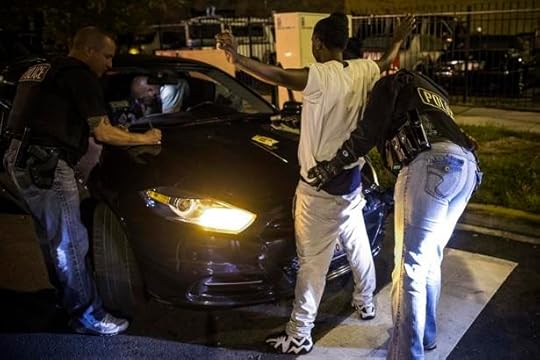
The U.S. Supreme Court weakened the Constitution’s protections against unlawful police stops on Monday, ruling that evidence found during those interactions could be used in court if the officers also found an outstanding arrest warrant along the way.
Justice Clarence Thomas, writing for a five-justice majority in Utah v. Strieff, concluded that a Utah police officer’s “errors in judgment hardly rise to a purposeful or flagrant violation of [Edward] Strieff’s Fourth Amendment rights.”
But in a thundering dissent, Justice Sonia Sotomayor was less forgiving. “The Court today holds that the discovery of a warrant for an unpaid parking ticket will forgive a police officer’s violation of your Fourth Amendment rights,” she wrote, joined by Justice Ruth Bader Ginsburg. “Do not be soothed by the opinion’s technical language: This case allows the police to stop you on the street, demand your identification, and check it for outstanding traffic warrants—even if you are doing nothing wrong.”
Later, writing only for herself, Sotomayor also added that the ruling “implies that you are not a citizen of a democracy but the subject of a carceral state, just waiting to be cataloged.”
The case began, as many Fourth Amendment cases do, with an apparently unlawful search. In 2006, Douglas Fackrell, a narcotics detective with the South Salt Lake City Police Department, conducted surveillance of a local house after receiving an anonymous tip. For a few hours over the course of a week, Fackrell watched people enter and leave the house for short periods of time.
Based on his experience, he interpreted these short visits as a possible sign that “drug activity” was taking place inside. Fackrell did not see when Edward Strieff entered the house, so he could not determine whether Strieff’s visit was short enough to arouse suspicions about a drug deal. But Fackrell followed Strieff to a nearby 7-11 parking lot nonetheless, where he stopped and questioned him about his visit to the house.
During that questioning, Fackrell also relayed Strieff’s personal information to a police dispatcher—a routine practice during police stops—and learned Strieff had an outstanding traffic warrant. He then arrested Strieff based on that warrant and searched his person, discovering a small amount of methamphetamine. Strieff was then charged and convicted for unlawful possession.
Generally speaking, evidence found during unlawful searches is supposed to be tossed out of court under the Fourth Amendment’s exclusionary rule. The rule’s rationale is fairly straightforward: If cops and prosecutors can still benefit from unlawful searches, what motivation would there be to not perform them?
Utah defended its prosecution of Strieff during his appeal by relying on the “attenuation doctrine,” an exception to the exclusionary rule that lower courts have struggled to coherently articulate. The doctrine ponders the connection between illegally obtained evidence and the misconduct that produced it. Put simply, if the connection between them is strong—if one directly led to the other—then the evidence is thrown out. If the connection is remote or if some intervening act “attenuates” or alters that connection, then the evidence can be used at trial.
For the majority, that calculus favored Utah. “The outstanding arrest warrant for Strieff ’s arrest is a critical intervening circumstance that is wholly independent of the illegal stop,” Thomas wrote. “The discovery of that warrant broke the causal chain between the unconstitutional stop and the discovery of evidence by compelling Officer Fackrell to arrest Strieff.”
In her dissent, Justice Elena Kagan disputed the majority’s portrayal of warrant checks as unusual. “They are the run-of-the-mill results of police stops—what officers look for when they run a routine check of a person’s identification and what they know will turn up with fair regularity,” she noted. “In short, they are nothing like what intervening circumstances are supposed to be.”
Thomas also excused Fackrell’s mistakes as “at most negligent.” First, he wrote, Fackrell didn’t know when Strieff had entered the house, so he had no way of knowing whether his visit was a short-term one, which could suggest “drug activity,” or not. Second, Thomas suggested, Fackrell should have approached Strieff differently by asking him to cooperate. But Thomas concluded these errors were made in good faith and did not justify the exclusion of evidence.
Kagan saw things differently. “Far from a Barney Fife-type mishap, Fackrell’s seizure of Strieff was a calculated decision, taken with so little justification that the State has never tried to defend its legality,” she wrote.
In her separate dissent, Sotomayor also denounced the majority’s ruling for misapplying the Court’s precedents on curbing unlawful searches.
“To the Court, the fact that a warrant gives an officer cause to arrest a person severs the connection between illegal policing and the resulting discovery of evidence,” she wrote. “This is a remarkable proposition: The mere existence of a warrant not only gives an officer legal cause to arrest and search a person, it also forgives an officer who, with no knowledge of the warrant at all, unlawfully stops that person on a whim or hunch.”
Citing federal civil-rights investigations like the Ferguson Report, she also pointed out how some police departments conduct otherwise unlawful searches under the guise of checking for outstanding arrest warrants. At least 7.8 million Americans have active warrants against them, she added, often for minor crimes.
“The majority does not suggest what makes this case ‘isolated’ from these and countless other examples,” she wrote. “Nor does it offer guidance for how a defendant can prove that his arrest was the result of ‘widespread’ misconduct. Surely it should not take a federal investigation of Salt Lake County before the Court would protect someone in Strieff ’s position.”
In one sense, her opposition to the ruling is unsurprising. Sotomayor has repeatedly voiced her concerns about weakening the Fourth Amendment’s protections. But Monday’s dissent is also extraordinary for its breadth and intensity, especially in the last of its four sections.
“Writing only for myself, and drawing on my professional experiences, I would add that unlawful ‘stops’ have severe consequences much greater than the inconvenience suggested by the name,” she wrote. Sotomayor then went on to detail how personally degrading a police search can be, shifting her literary style to address the reader directly. (I’ve removed the citations for ease of reading.)
This Court has allowed an officer to stop you for whatever reason he wants—so long as he can point to a pretextual justification after the fact. That justification must provide specific reasons why the officer suspected you were breaking the law, but it may factor in your ethnicity, where you live, what you were wearing, and how you behaved. The officer does not even need to know which law you might have broken so long as he can later point to any possible infraction—even one that is minor, unrelated, or ambiguous.
The indignity of the stop is not limited to an officer telling you that you look like a criminal. The officer may next ask for your “consent” to inspect your bag or purse without telling you that you can decline. Regardless of your answer, he may order you to stand “helpless, perhaps facing a wall with [your] hands raised.” If the officer thinks you might be dangerous, he may then “frisk” you for weapons. This involves more than just a pat down. As onlookers pass by, the officer may “‘feel with sensitive fingers every portion of [your] body. A thorough search [may] be made of [your] arms and armpits, waistline and back, the groin and area about the testicles, and entire surface of the legs down to the feet.’”
“Even if you are innocent, you will now join the 65 million Americans with an arrest record and experience the ‘civil death’ of discrimination by employers, landlords, and whoever else conducts a background check,” she noted, citing academic works by criminal-justice scholars Gabriel Chin and James Jacobs.
Sotomayor then pivoted into the racial dimension of suspicionless stops and unconstitutional searches. Her citations, which I’ve omitted for ease of reading, double as a canon for modern critiques of mass incarceration: the landmark texts of Michelle Alexander and Marie Gottschalk, as well as the writing of W.E.B. Du Bois, James Baldwin, and Ta-Nehisi Coates.
“The white defendant in this case shows that anyone’s dignity can be violated in this manner,” she wrote. “But it is no secret that people of color are disproportionate victims of this type of scrutiny. For generations, black and brown parents have given their children ‘the talk’— instructing them never to run down the street; always keep your hands where they can be seen; do not even think of talking back to a stranger—all out of fear of how an officer with a gun will react to them.”
Few institutions in American life have grappled with race and racism like the U.S. Supreme Court, for better or worse, but rarely does it speak about it with this level of detail. Sotomayor’s dissent also ends with what could be read as a veiled nod to the Black Lives Matter movement.
“We must not pretend that the countless people who are routinely targeted by police are ‘isolated.’ They are the canaries in the coal mine whose deaths, civil and literal, warn us that no one can breathe in this atmosphere,” she wrote, citing a 2002 book by two legal scholars who argued abuses against people of color often foreshadow broader injustices. (One could also read it as a reference to the death of Eric Garner.)
“They are the ones who recognize that unlawful police stops corrode all our civil liberties and threaten all our lives,” she concludes. “Until their voices matter too, our justice system will continue to be anything but.”

Orange Is the New Black: ‘Bunny, Skull, Bunny, Skull’
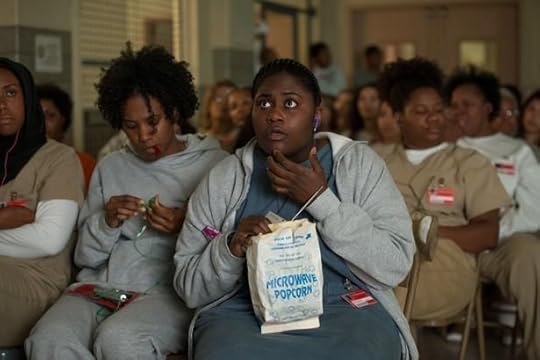
For the fourth season of Orange Is the New Black, Spencer Kornhaber and Sophie Gilbert are discussing the series via recaps, taking turns to analyze one episode at a time. Spoilers abound; don’t read further than you’ve watched.
Episode 10, “Bunny, Skull, Bunny, Skull”
Read the review of the previous episode here.
“Bunny, skull, bunny, skull,” in addition to being a pretty zany manicure option, is also an apt metaphor for how season four is unraveling. This episode opened with warm fuzzies (Aleida hugging Daya and moonwalking her way out of jail) and closed with a human hand being dug up from underneath the prison garden. Bunnies! Skulls! Feel-good family moments! Rotting corpses! It’s enough to make a binge-viewer feel dizzy, but somehow, it works.
By unifying the prison’s isolated white supremacists, Piper has indeed, as she told Alex, created a monster. Maybe not one that threatens the inmates as directly as Piscatella’s John Yoo-approved disciplinary techniques, but definitely one that can make enough noise to ruin Taystee’s eagerly awaited screening of The Wiz. Meanwhile, Blanca is still standing on the table, and Piper’s entreaties to Piscatella that “standing for prolonged periods of time causes irreversible joint damage” seem to trouble him as little as the fact that she might, you know, die of dehydration. Alex noted that the prison’s rapidly turning into “some kind of grotesque social experiment,” and she isn’t wrong.
More Orange Is the New Black
[image error]
Ep. 8: ‘Friends in Low Places’
Ep. 9: ‘Turn Table Turn’
As far as grotesque things go, though, it’s hard to top the scene from last week, when Humps forced Maritza to confront the repulsive manifestation of her thought experiment regarding eating 10 dead flies versus one live baby mouse. After she rushed to the bathroom to throw up (and the guards pondered whether Humps had raped her as casually as they might have wondered if he’d made her a cup of tea), Flaca finally compelled her to explain what had happened, and Maritza’s description of feeling the mouse toenails catching in her throat was gag-inducing. So yes, Humps is a psychopath, and an animal torturer, but he’s only degrees worse than the rest of the guards, who all seem to delight in making the inmates perform increasingly painful tricks for their amusement. As Flaca said, “Those guards, they can do whatever the fuck they want.”
The exception, of course, is Luschek, who admitted to Nicky that he got roped into having sex with Judy King while Nicky was rifling through his workbox for drugs. (“It was very Harold and Maude.”) Nicky’s been cut off thanks to Red threatening all the suppliers in the prison—Ruiz, Angie (who was starting to get grossed out by the shower pooping anyway), and Officer Dixon, who rivals maybe Piscatella in sheer awfulness.
All season, people have been making digs at Caputo for adopting the trappings of his fancy new job and not spending any time in the actual prison. But in this episode, he at least seemed to be taking some time on a mission for good: Reading dannytalkstruth.com (wasted opportunity for Mike Birbiglia-centric marketing there) and sneaking a picture of Sophia in SHU on Sister Ingall’s confiscated cellphone. If it doesn’t fully make up for the fact that Litchfield under his watch has become a less balmy version of Guantanamo, it at least shows that he’s aware of how rotten MCC is as an institution, to the point where he’s willing to leak photographs of an inmate to a whistleblower to help get her out.
One of the more moving storylines this episode involved Aleida post-release. Orange hasn’t fully explored the transition into the outside world since Taystee left the prison in season one and deliberately violated her probation so she could return to Litchfield. The story that the new guard, McCullough, told Aleida right before she left about an inmate being released in the middle of the night and being picked up for suspicion of prostitution as she tried to walk to town captured the revolving door of recidivism—even when prisoners don’t want to reoffend, they’re permanently hindered by their incarceration in a way that makes it almost impossible for them not to.
For Aleida, this meant going to stay with her boyfriend’s pregnant new girlfriend because she had nowhere else to go, and trying to explain how she felt without being grilled about prison clichés: “It’s hard, and it smells like old farts, but I got people in there. I got nobody out here.”
Best line: “I’m looking for those letters I wrote you. I’m hoping to recycle them in a ‘Fuck You’ origami.” Nicky.
Questions: Will Aleida end up back in jail, or will she get her kids back? How ugly are things going to get with C.O. Piscatella now one of the guards has turned up in pieces under the tomatoes? What exactly is wrong with Kukudio?

The Immigration Battle at the Heart of Brexit

A former British minister’s apparent about-face on the U.K.’s continued membership in the European Union illustrates the central role immigration is playing both sides of the “Brexit” debate.
Sayeeda Warsi said Monday she was now backing the “remain” campaign after, in her words, the “leave” campaign had abandoned its moderate message to become “small-minded, xenophobic and inward-looking.” Her remarks to The Guardian:
The vision that the Brexit campaign is presenting is not the vision that me and other Brexiters started off with a year ago. The ‘hello world’ approach to Brexit, which is open-minded, visionary, inclusive, has been lost. The moderate message has been lost. And instead we have reverted to a campaign that says: ‘The Turks are coming, the Syrians are coming, the refugees are coming, the Muslims are coming, the terrorists are coming’.
Indeed, Warsi’s remarks are an apparent reference to a poster released last week by Nigel Farage, the head of the U.K. Independence Party (UKIP), which favors the U.K. leaving the EU. Here’s that ad:
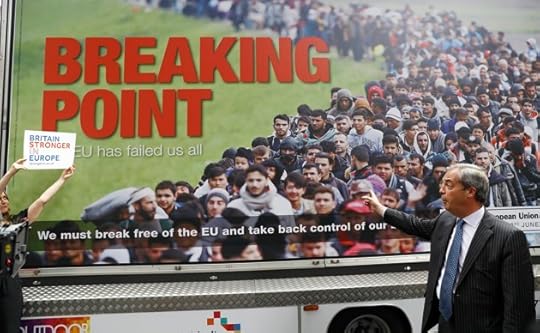
Stefan Wermuth / Reuters
The image on Farage’s poster was one of Syrian and other refugees and migrants walking through the heart of the European countryside to reach Germany, Sweden, and other western European nations, as Europe grapples with its most severe refugee crisis since World War II. Britain, like much of the rest of Europe, has been wary of letting in large numbers of these migrants and refugees. The U.K. retains substantial autonomy over how many immigrants it accepts from outside the EU. By contrast, though, under EU rules the U.K. cannot limit migration from within Europe, and has to extend to those migrants much of the same rights and privileges it gives its own citizens. It’s unclear if Brexit would actually reduce immigration to the U.K. About half of the migrants to Britain come from non-EU countries, and previous efforts to curb immigration have had limited success. Still, Farage’s poster struck a chord—or nerve—depending on your viewpoint.
It’s important to point out here that Farage’s ad was a UKIP poster—and not one issued by the official Vote Leave campaign, which is headed by Boris Johnson, the former London mayor who, like Warsi, is from the ruling Conservative Party. Indeed, many of those who support Brexit distanced themselves from the poster, while those who support Britain’s continued membership in the EU labeled it racist and, in an example of Godwin’s law as well as how far each side is willing to go to tarnish the other, highlighted some of the similarities it shared with World War II-era Nazi propaganda.
.@StripyMoggie Can't help but make a Nazi comparison to this rhetoric. pic.twitter.com/W209C6HjLT
— Brendan Harkin (@brendanjharkin) June 16, 2016
But even those who support Britain’s continued membership in the EU, and indeed believe that it makes the U.K. stronger, have been skeptical about immigration. In February Prime Minister David Cameron, who is supporting the “remain” campaign, had secured a host of concessions from the EU on issues including benefits paid to EU migrants. And Jeremy Corbyn, the head of the Labour Party, who is also supporting the U.K.’s continued EU membership, said over the weekend: “I don’t think you can have [an upper limit to immigration] … while you have free movement of labor.” The comments were seized upon by his rivals in the debate. But those rivals have also been quick to distance themselves from Farage’s poster. Johnson criticized it, and said Britain’s exit would help “neutralize anti-immigrant feeling.” He added he was “passionately pro-immigration and pro-immigrants,” and went as far as to call for an amnesty for immigrants illegally in the U.K. for 12 or more years because it was “the humane thing to do.”
Farage has stood his ground, insisting the only reason he’s being criticized is because of the assassination last week of Jo Cox, the pro-remain Labour Party member of Parliament. And while Michael Gove, the justice secretary and leave campaigner, said Farage’s poster made him “shudder,” he has also previously warned of the consequences of Turkey’s accession to the EU, saying it would pose a security risk to Britain as part of his argument for why Britain should leave the bloc. (The prospect of Turkey joining the EU in the near- or medium-term is dim.)
Warsi, the former minister, told The Guardian she had hoped the debate over Brexit would become more measured following Cox’s assassination, but “when I turned on the television on Sunday morning and saw Nigel Farage defending the indefensible and Michael Gove continue to peddle lies about Turkey’s accession to the EU, that for me was a step too far.”
The referendum is on Thursday—and polls show a statistical dead heat.

The Deadly 'Heat Dome' Scorching the Southwest

A heatwave across the American Southwest has been blamed for the death of four people in Arizona, and put 30 million people under heat warnings or advisories.
In Arizona, the cities of Flagstaff, Tucson, Yuma, and Phoenix all saw record-breaking temperatures—the hottest at 120 degrees Fahrenheit—over the weekend. The heat was blamed in the deaths of four hikers––two near Phoenix, and two near Tucson.
CNN reports the heatwave is the result of what is called a “heat dome”:
... a pattern that can lead to record-setting temperatures and heat waves -- according to CNN Meteorologist Rachel Aissen. A heat dome occurs when air is capped by the upper atmosphere in the same location: The air hits the cap and returns to the surface, continuing to heat it like a convection oven.
In Southern California, near San Diego, the National Weather Service issued an excessive heat warning for everywhere but coastal areas, and temperatures in 14 cities broke heat records. To the north in Santa Barbara, a wildfire has grown to almost 8,000 acres and has burned for nearly a week thanks to the heat and dry winds. Another fire in New Mexico has burned nearly 18,000 acres, and one in Arizona has scorched almost 28,000 acres, doubling in size over the past day. In all, wildfires have burned nearly 2 million acres in the U.S. this year, which is 200,000 acres above average so far.
Sunset during the Cedar Fire today. pic.twitter.com/wOV8Sv96gN
— Chris Gros (@ChrisGrosABC15) June 20, 2016
Extreme heat kills more people each year in the U.S. than flooding, tornadoes, cold, or hurricanes. Temperatures are expected to remain high until Thursday, after which they may cool slightly; in Phoenix, that means down to the low 110s.

The Orlando 911 Transcripts
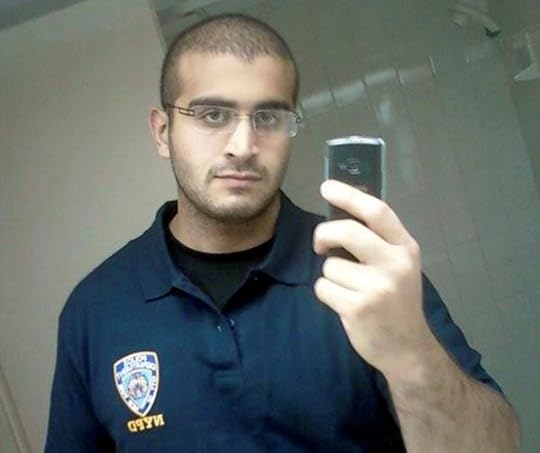
Updated on June 20 at 3:24 p.m. ET
Hours after releasing a partial transcript of the conversations between the police and Orlando shooter Omar Mateen, the FBI and the Justice Department released a full transcript of the conversation, saying the redaction had “caused an unnecessary distraction from the hard work that the FBI and our law enforcement partners have been doing to investigate this heinous crime.”
“As much of this information had been previously reported, we have re-issued the complete transcript to include these references in order to provide the highest level of transparency possible under the circumstances,” they said in a statement.
Mateen killed 49 people at Pulse, a gay nightclub in Orlando, Florida, on June 12. The new transcript names Mateen as the shooter, and in it, he says: “My name is I pledge of allegiance to Abu Bakr al-Baghdadi of the Islamic State.”
The earlier redacted transcripts, details of which are included below, named neither the shooter nor the group to which he pledged allegiance.
Here’s his first call with a police dispatcher:
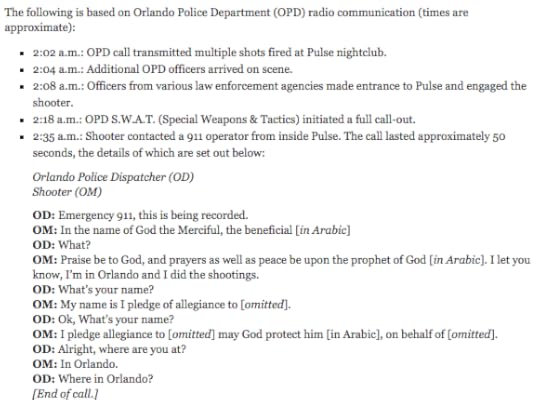
Soon after that, the shooter spoke three times with the Orlando Police Department’s crisis-negotiation team. Here’s the transcript:
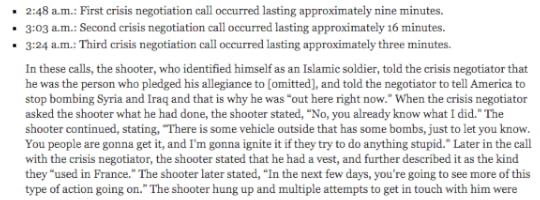
The FBI’s news release then describes a timeline of law-enforcement authorities’ actions to rescue those still inside Pulse.
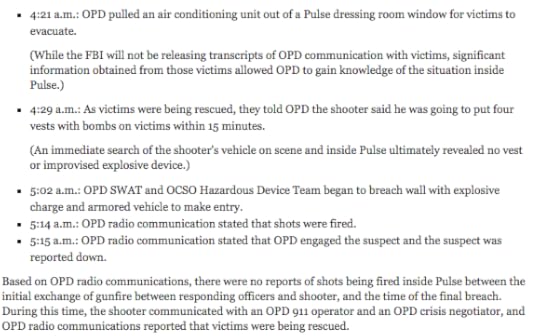
Ron Hopper, the FBI’s assistant special agent in charge of the Tampa field office, said the bureau was not going to name the shooter or the militant group because it did not want to aid in terrorist propaganda.
On Sunday, Attorney General Loretta Lynch said on ABC’s This Week that the goal of the partial transcript was for “people [to] … see the type of interaction that was had there.”
Mateen was killed by police after a three-hour standoff inside the Pulse nightclub. He reportedly pledged allegiance to the Islamic State during the conversations with police, though at this point it appears Mateen was radicalized over the internet and inspired by the group rather than directed by it to stage the attack that has been described as the worst mass shooting in U.S. history.

The Crackdown at Euro 2016

More than 500 people have been arrested in the first 10 days of the monthlong European Championship in France that has been punctuated by the actions of rowdy and sometimes violent fans.
France’s interior minister, Bernard Cazeneuve, said Monday 557 “violent supporters” were arrested at Euro 2016, the men’s soccer tournament that takes place every four years, the AP reported. Twenty-one fans were jailed, six received prison sentences, and another 25 were ordered to be deported.
Among those set to be deported are 20 Russian fans who clashed with English fans before and after the competition’s opening game in Marseille on June 11, the worst violence of Euro 2016 so far. Police deployed tear gas into the crowds as fans brawled, and dozens were injured. English fans said the Russian fans appeared intent on assaulting them. One described the scene to The Guardian last week:
“They were very organised,” said Ian Allsop, a builder from Luton. “They wore gumshields, some had England shirts on to mix in. They were there to do the English. And they were thickset, stocky guys. People were getting bottles smashed on their heads, bats smashed into them. Loads of people were hurt.”
Allsop said he had been looking for his 24-year-old son during the violence when he was attacked. “About 300 Russians came out of nowhere. They just walked straight through all the England fans who were standing about singing,” he said. “The Russians just started hitting anyone they could.
In response, UEFA, soccer’s governing body in Europe, fined Russia 150,000 euros ($168,000) and handed down a suspended disqualification, which means the national team will be kicked out of the tournament if the country’s fans continue to misbehave.
The actions of fans from other countries have also prompted the wrath of UEFA. The agency on Monday fined Croatia 100,000 euros ($113,000) because Croatian fans threw flares onto the field during Friday’s match between Croatia and the Czech Republic, causing referees to pull players off the pitch in the 86th minute.
The next matches will take place Monday night; Russia will play Wales, and Slovakia will face England.

Malawi’s Elephant Road Trip

Wildlife experts in Malawi next month will begin moving up to 500 elephants to a new preserve in the country in what is considered the largest-ever pachyderm relocation in Africa.
The elephants will be transported from Majete and Liwonde, two wildlife parks that have become overcrowded, to a new 42,000-acre sanctuary inside the Nkhotakota Wildlife Reserve, about 300 kilometers, or 185 miles, away. Officials say they hope the elephant population will grow there, helping to replenish the numbers of a threatened species.
The relocation will take about a year, the AP reports. The operation “will involve darting the elephants from a helicopter, hoisting the slumbering animals by crane, and loading them in crates onto trucks” for the drive to Nkhotakota. Animals will be moved in small groups in July and August, and then again in the same period next year. Zebras, buffalo, impalas, waterbucks, and other species will also make the trip.
The journey and the new preserve are managed by African Parks, a nonprofit organization that manages 10 parks in seven African countries. The group in February received 2.6 million euros, or $2.9 million, from a Dutch charity lottery to be used in the move.
Malawi’s elephant population, like in other African nations, is presumed to be declining. Exact figures are difficult to calculate, but populations have shrunk in the last few decades as poachers slaughter elephants for their tusks for the illegal and growing trade in ivory. In March of this year, the Malawi government set aflame and destroyed 781 pieces of ivory worth nearly $3 million that had been confiscated in 2013 from smugglers traveling from Tanzania to Malawi.

A Deadly Father's Day Weekend in Chicago

Over the Father’s Day weekend, 13 people were killed and 42 others were injured in gun violence in Chicago. One of the victims was a 3-year-old boy, who was shot in the right shoulder on the city’s South Side on Sunday. He is in critical condition.
The deadliest stretch of the weekend occurred from Friday night into Saturday, when five people were killed and nine were injured in shootings across the city. The Chicago Tribune reports:
Four of the fatalities occurred in seven hours. The fatalities included a 16-year-old boy who was killed in West Englewood about 9:05 p.m. Friday. He was in the front passenger seat of a car driving through an alley in the 6500 block of South Hamilton Avenue when two males came up and fired shots, according to police.
On Sunday, a 21-year-old man was shot with an AK-47 and was killed on the South Side, police said.
According to the Chicago Tribune, this brings the total number of people shot in the city this year to 1,780. Summer violence is expected to increase in the coming weeks.

Atlantic Monthly Contributors's Blog
- Atlantic Monthly Contributors's profile
- 1 follower



